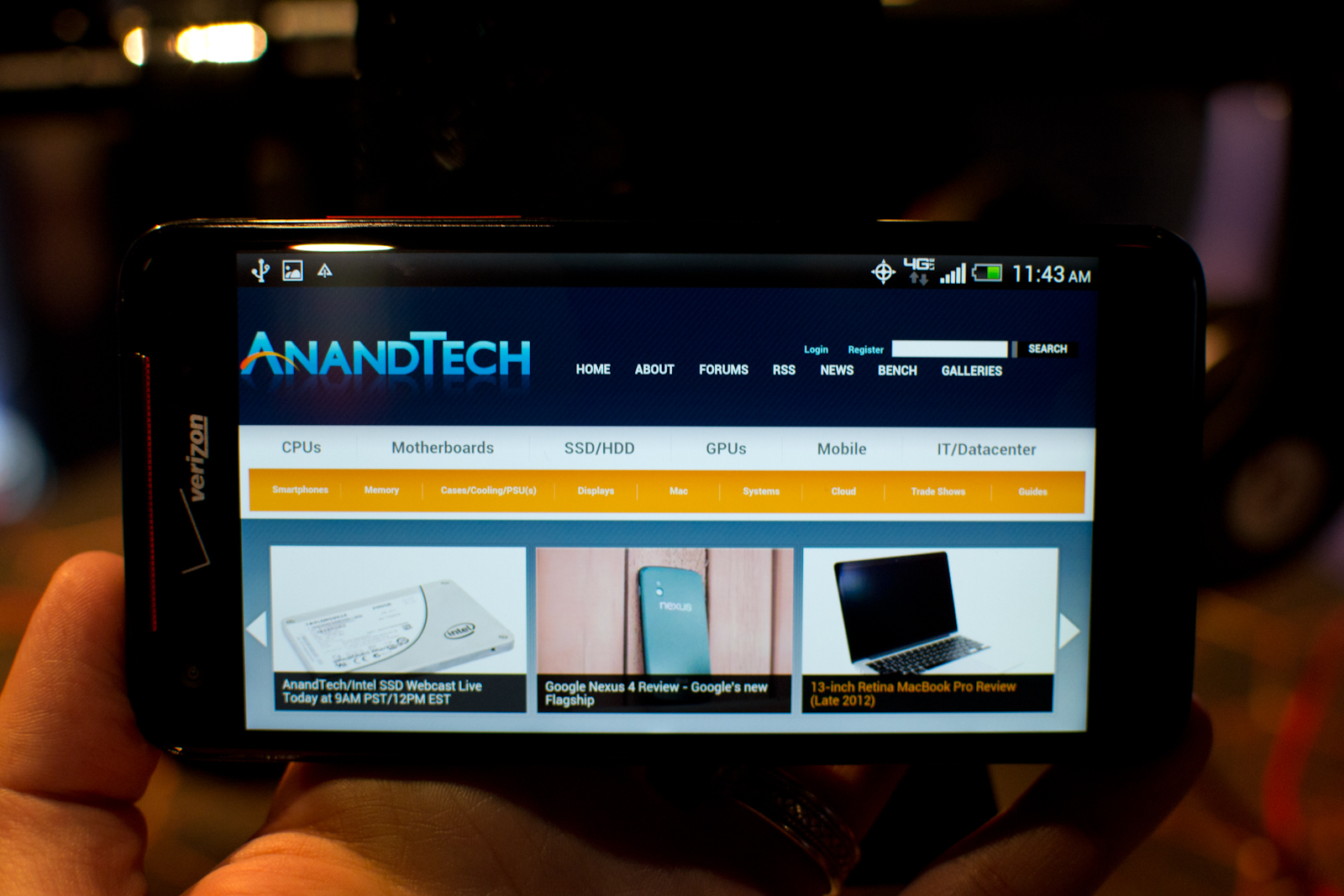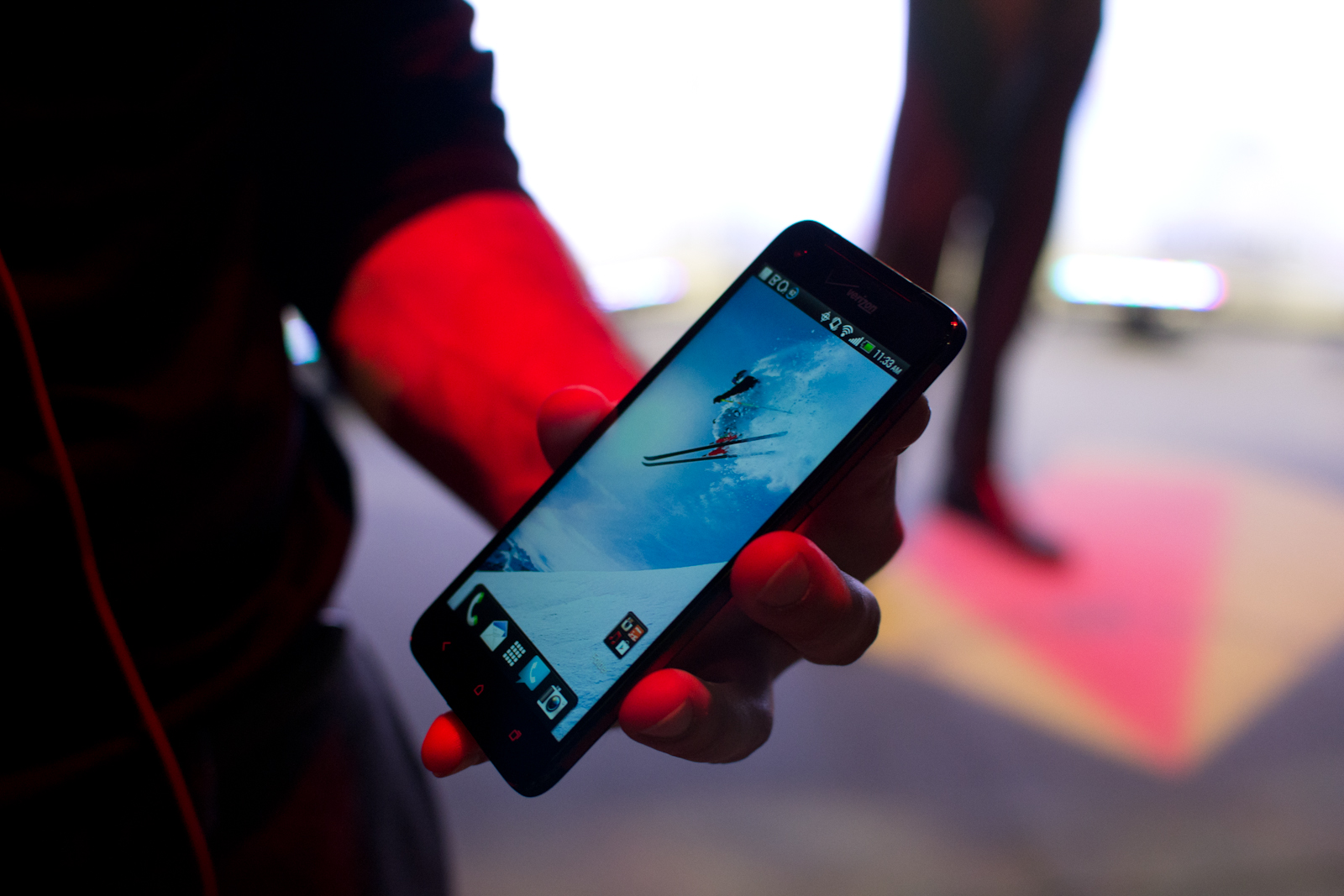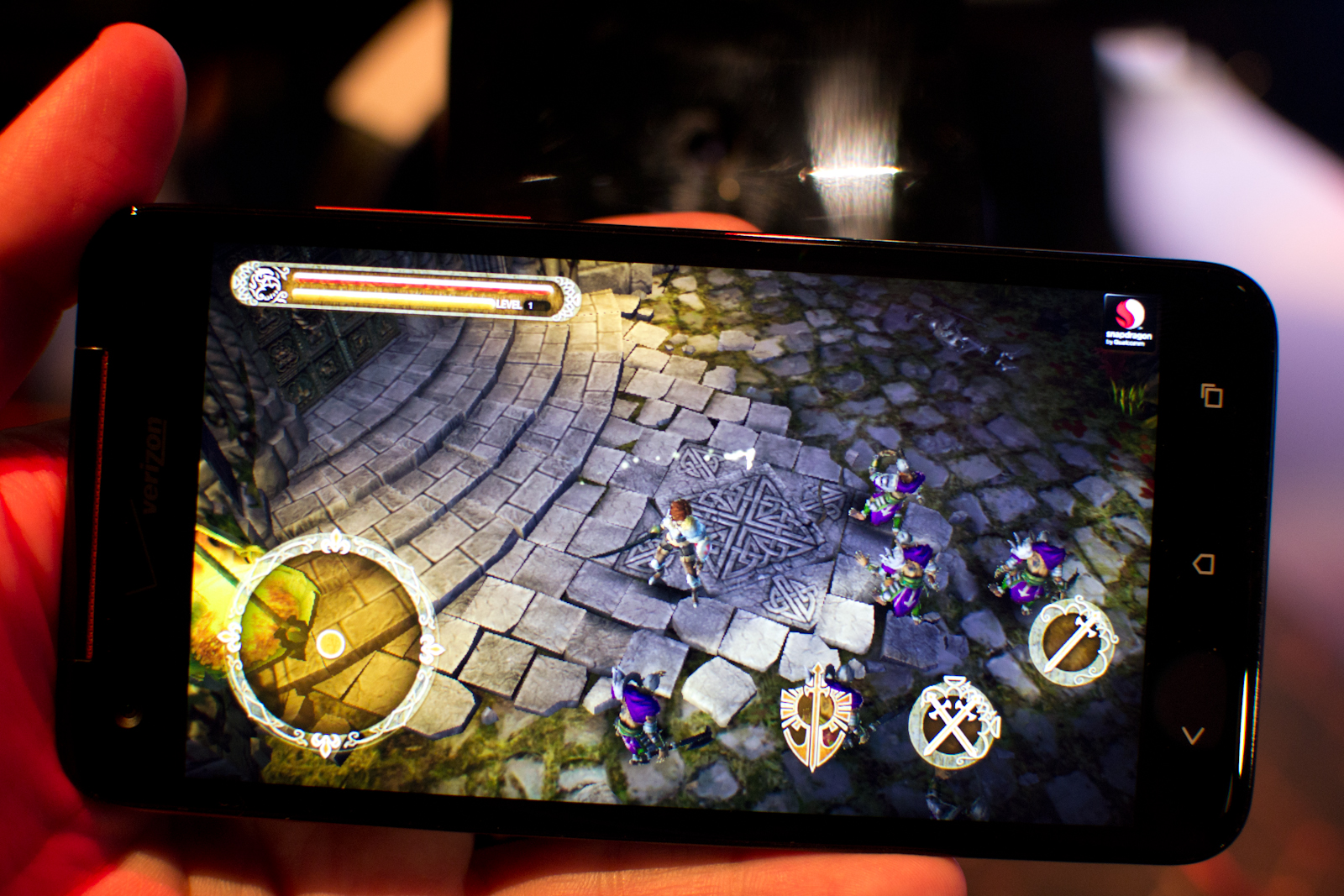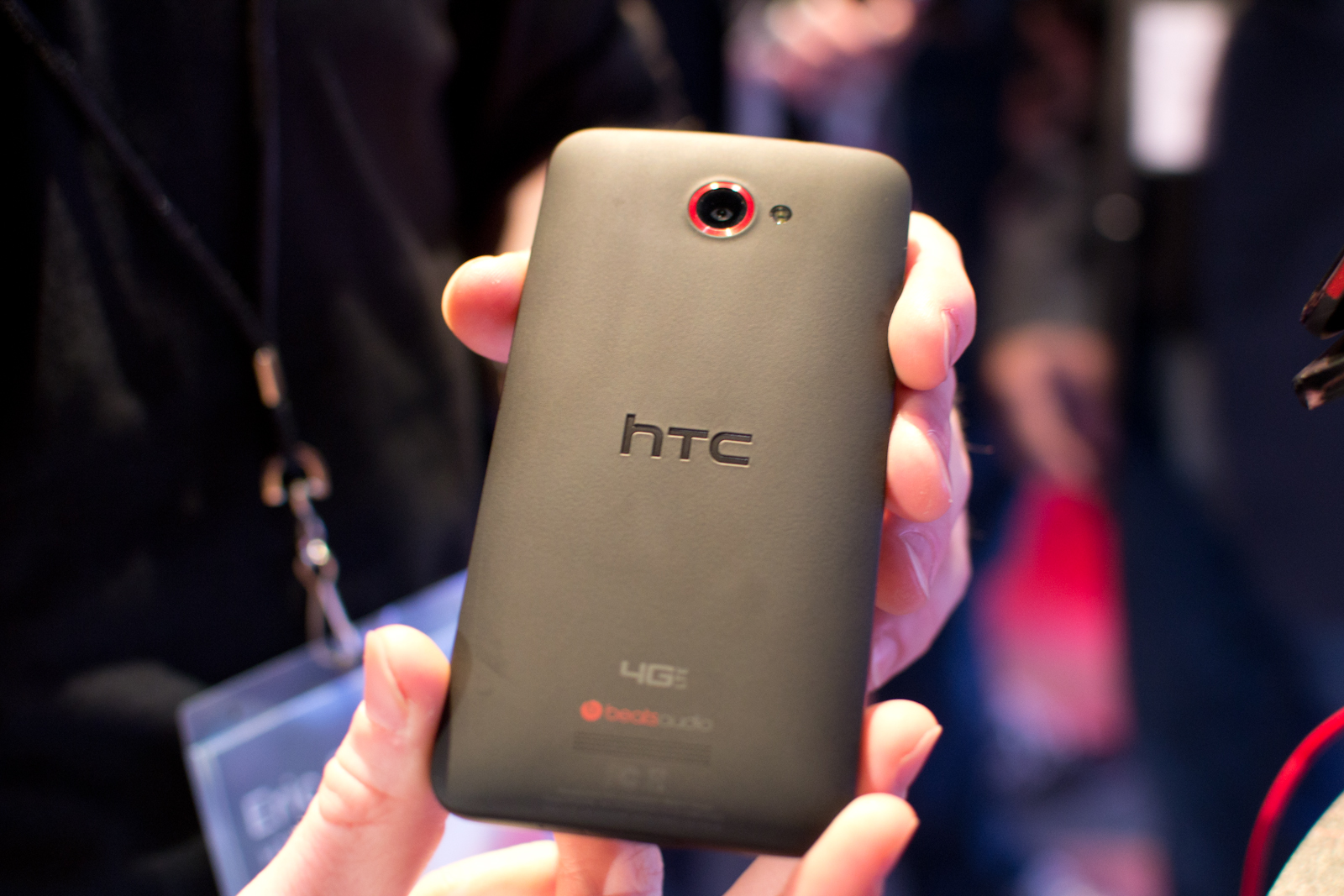HTC Droid DNA Hands-On
by Jason Inofuentes on November 13, 2012 12:22 PM EST- Posted in
- Smartphones
- Snapdragon
- HTC
- Verizon
- Mobile
- APQ8064
- droid dna
Today’s HTC Droid DNA announcement brings a few big advancements over the HTC One X that never made it to Verizon's line-up. We'll start our hands-on discussion with the most obvious change: the screen.
The Display

The rapid advance of screen technology means that we're just a year removed from the arrival of 720p displays, and just two years removed from WVGA being the defacto resolution. Today we see the efforts of Sharp’s display team come to fruition with a seemingly uncompromised 5" 1080p display. The pixel density is an unchallenged 440 ppi, and it seems to retain the brightness and fidelity of its predecessors, most recently seen in the HTC One X.

Hands-on events aren’t the place for detailed analysis, the time is too short, and the venues to cramped to pull out a colorimeter. What I will say is that the display is easy on the eyes and offers such a glut of pixels that no amount of squinting allowed me to discern. Viewing angles seemed good, with no distortion noted, and colors were bright without being oversaturated. So, at first glance, a somewhat expected excellent for the display. Here’s the thing: do we want a 1080p 5” display? At this pixel density, we would be approaching an angular subtense of two thirds of a degree. That's well below the human ability to discern at twelve inches. So is the likely battery hit worth the improved pixel density? We'll have to wait and see.
The Design

The great display is surrounded by narrow bezels all around, and the result is a body that is just 6.2 mm longer than the One X, despite the larger screen, and less than a millimeter wider. Gorilla Glass 2 is used and actually extends across the entire face of the device and forms part of the edge of the handset, a surefire sign of confidence in the strength of the glass. The effect is to make the front glass and back seem fused into one solid piece. Accent grills adorn the sides of the device, in the bright red we’ve come to expect from HTC phones on VZW. The back is a softly curving single expanse of matte black, with the HTC logo etched and inlayed in silver. An LTE logo, Beats Audio logo and the single speaker grill grace the bottom of the back, and the 8MP rear-shooter sits at the top. One particularly unique feature on the back is a concealed status LED to the left of the camera lens. When the phone is face down and a notification is received, the LED will blink to alert the user. The LED is also used to alert self-shooters when the shutter will release.

At nearly a centimeter at its thickest point, this is not the thinnest phone; but the way the back tapers down to the edge gives it an excellent in the hand feel, and makes it feel thinner than its specifications would indicate. Despite deviations from the One series design language, the solidity that defines that lineage can be seen here.
| Physical Comparison | ||||
| HTC Droid DNA | HTC One X (AT&T) | Samsung Galaxy S 3 (USA) | LG Nexus 4 | |
| Height | 141 mm (5.55") | 134.8 mm (5.31" ) | 136.6 mm (5.38") | 133.9 mm (5.27") |
| Width | 70.5 mm (2.78") | 69.9 mm (2.75") | 70.6 mm (2.78") | 68.7 mm (2.7") |
| Depth | 9.73 mm (0.38") | 8.9 mm (0.35") | 8.6 mm (0.34") | 9.1 mm (0.36") |
| Weight | 142 g (5.01 oz) | 129 g (4.6 oz) | 133 g (4.7 oz) | 139 g |
| CPU | 1.5 GHz APQ8064 (Quad Core Krait) | 1.5 GHz MSM8960 (Dual Core Krait) | 1.5 GHz MSM8960 (Dual Core Krait) | 1.5 GHz APQ8064 (Quad Core Krait) |
| GPU | Adreno 320 | Adreno 225 | Adreno 225 | Adreno 320 |
| RAM | 2 GB LPDDR2 | 1 GB LPDDR2 | 2 GB LPDDR2 | 2 GB LPDDR2 |
| NAND | 16 GB NAND | 16 GB NAND | 16/32 GB NAND with up to 64 GB microSDXC | 8/16 GB NAND |
| Camera | 8 MP with AF/LED Flash, 2.1MP front facing | 8 MP with AF/LED Flash, 1.3 MP front facing | 8 MP with LED Flash + 1.9 MP front facing | 8 MP with AF/LED Flash, 1.3 MP front facing |
| Screen | 5" 1920 x 1080 LCD-TFT | 4.7" 1280x720 LCD-TFT | 4.8" 1280x720 HD SAMOLED | 4.7" 1280x768 HD IPS+ LCD |
| Battery | Internal 7.47 Whr | Internal 6.66 Whr | Removable 7.98 Whr | Internal 8.0 Whr |
The Camera
Cameras, like displays before them, were long ignored as just value adds, and not features that must be optimized and perfected. It’s really exciting to see manufacturer’s compete for the best phone camera and not just through software trickery. HTC’s approach is, perhaps, the most traditional, and that is to provide an optical package that mimics the higher-end discrete glass you’d find on a proper SLR. The same f/2.0 28mm optics package is used here, as in the One X, and most likely the same sensor is in play. The ImageChip ISP remains a feature, and the software (now called Sense 4+) has a few additions to improve usability. It’ll be interesting to see how Sense 4+ and Android 4.2’s new camera software will play together, but for now the camera seems intuitive and the results look to match that of the One X.
The front-camera from the HTC WIndows Phone 8X finds a home here, bringing its f/2.0 optics, ultra-wide angles and 2.1MP sensor, which shoots 1080p video.
The SoC
Obviously, we’ve spent a little time with this particular SoC, recently. UI performance was smooth, and hard to trip up, even with the graphical flourishes HTC favors. The home screen carousel is no more, but cycling through home screens remains a wrap around affair and a second tap on the home button still brings an overview of all your home screens. All those flourishes render fluidly, and hopping in an out of apps and the app drawer, I didn't notice any particular hiccups. Performance should be excellent in our typical tests, based on SoC alone, but software is always a key component to the experience, and it'll be interesting to see how this S4 Pro equipped handset differs from the Nexus 4 and LG Optimus G.
The Audio
HTC has been focusing on handset audio for sometime, including their investment in and use of Beats Audio's DSP algorithms. Beats Audio remains, and there’s even a VZW tie-in with the Beats Pill, a portable Bluetooth speaker. Added to the mix is a dedicated 2.55v headphone amp, which should be able to drive even the most high-end cans. Sound quality should be improved in all headphones, and they were certainly able to power my modest earbuds well. No specifics were provided, but a dedicated amp for the rear speaker should give audio a boost there, as well. This sort of focus on audio quality is always nice to see, and we’ll be excited to put the DNA through its paces to see how it stacks up.

















54 Comments
View All Comments
nerd1 - Tuesday, November 13, 2012 - link
Two deal breakers.The biggest concern for any smartphone is the battery life and storage space. Putting a mere 2000mAh battery for 5 incher is a big joke. GN2 has hefty 3100mAh battery, and it is replaceable. You can get a replacement battery dirt cheap, and recharge them separately (you don't have to plug in your phone and stay around it!), which will provide a good 20+ hrs of usage, say for a intercontinental flight.
And why bother to put a full HD display, if your storage cannot house a single full HD movie file at all?
Now micro SDXC's are getting cheaper and cheaper. Cloud storage? That's find for tiny documents, but do you really want to use your monthly data capacity downloading a single file?
One X was a very good device, and its display was one of the best in the world already.
IMO rather than uselessly pursuing ppi, they should provide micro SD port and replaceable battey.
andrewaggb - Wednesday, November 14, 2012 - link
agreed. The sd thing only matters to me for movies and music.Until we are measuring battery life in days or weeks and not hours... battery is just as important as the display and speakers.
This a nice looking phone, I just really wish HTC would aim higher. If this had the best screen, best sound, best battery life, lots of storage... you'd at least get lots of techie's buying it.
smartthanyou - Wednesday, November 14, 2012 - link
Well since we don't have a good idea on what kind of usage the DNA will get out its battery yet, your complaint about the capacity is just more pointless yapping. The fact that another phone goes longer on a charge is only relevant if the DNA doesn't meet your needs.
Apparently, you need 20 hours of continuous use on your cell phone because you frequently are on intercontinental flights. The DNA is probably not for you. However you do understand that most people have no such requirement?
Also, in regards to storage, I think the sell out of Nexus 4 16GB proves that there are many people that find that amount of storage just fine.
Certainly, the DNA's lack of expanded storage or user replaceable battery will be deal breakers for some, however, for most it won't be a problem. Those users will get by just fine and they will have a phone with the best display currently available for a smart phone.
Wardrop - Wednesday, November 14, 2012 - link
Yeah, the amount of storage really is a deal broker. I mean, this is a seriously spec'd out phone, and NAND is less than $1/GB - it makes no sense for a phone in this price range. The fact it's got 1080p warrants more storage even further. If you're not going to provide a microSD card slot, there should be a 32GB and 64GB model - 16GB shouldn't even be an option for a phone in this price bracket.Rick83 - Wednesday, November 14, 2012 - link
But that's an endemic problem to the industry.The Galaxy Note 2 isn't even going to be available here with 32GB this year - so currently the real-life mark-up is some 200 euros for 16 GB of integrated flash.
I've had 32GB in my Archos 5 THREE BLOODY YEARS AGO! in that form factor.
It's ridiculous, that a quad core SoC phone comes with less RAM than an 800MHz OMAP 3440....
Someone should come up with another differentiating factor, as using flash memory is so blatantly artificial, that it's ridiculous.
SpitUK - Wednesday, November 14, 2012 - link
Whats the game thats shown?JasonInofuentes - Wednesday, November 14, 2012 - link
Reign of Amira, a game Qualcomm developed in house to show-off the Adreno 320. It's first chapter will ship on the DNA free as an exclusive for sometime.Jason
Skidmarks - Wednesday, November 14, 2012 - link
A couple of years back the bragging rights were all about how tiny your phone was. Now look at the size of these things. It would probably pay to be in the tailoring business so you can design & make custom reinforced pockets to accommodate them. After you've cracked that you can move onto handbags.policeman0077 - Wednesday, November 14, 2012 - link
I don't know why now there is a trend that screen gets bigger and bigger. In fact, it is not easy to use (use your right thumb to reach up-left corner of screen), not compact enough for carrying in pocket and consumes a lot of battery. Besides, it looks not very elegant, when I saw someone using galaxy note make phone call, I just want to beat them on their face (I don't why)........amdwilliam1985 - Wednesday, November 14, 2012 - link
so glad you're not around when I make wifi-call on my Nexus 7, don't want to get beat up.I love the look on other people's faces, yes, I'm making calls on my Nexus 7, now hide your iTiny and be ashame of yourself ;)